




|
| Þingvallavatn (Þingvellir Lake) on an overcast morning |
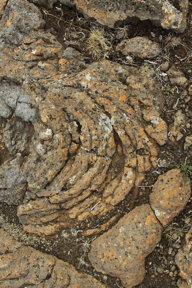
|
|
When I saw this patch of folded lava, I knew that I’d probably be using a shot of it for the background of these pages. |
An eventful day, with lots of photos to deal with, though rather overcast for most of the time, so they don’t sparkle at all.
We started the day with a pleasant enough hotel breakfast that starred (for me) a sufficiency of pickled herring. We met in the lobby to start out, and this is when we were introduced to the remaining two members of the group, Barbara Grimm and Kay Burdette, sisters from the Midwest and the Southwest, respectively, who’ve evidently done a lot of traveling together.
Icelandic has a bunch of letters beyond the ones we're familiar with, but the two that stand out are thorn (þ) and eth (ð). They give the voiceless and the voiced ‘th’ sounds, respectively, so that “thing”, a perfectly good Icelandic word, is spelled þing; and there’s a word that’s pronounced pretty much like our word “loathe”, but it’s spelled lóð.
The word Þingvellir just means “Assembly Plains,” so Þingvallavatn means “Assembly Plains Lake.”
Þingvellir! Our first stop, first walk in this busy day. It’s important historically, culturally, and geologically. From the geological side, it’s the most obvious part of the great rift valley that splits Iceland in two, as a result of mid-ocean spreading with the Eurasian and North American plates pulling apart at something like two centimeters per year. Culturally, it’s the heart of the nation, the place where the most important national events are celebrated or take place, such as full independence from Denmark and the declaration of the modern Icelandic Republic in 1944.
I find the story fascinating: nobody in Iceland could write in the tenth century, but they had what can only be considered to be a written constitution. The whole body of laws was committed to memory by the Lawspeaker, an elected official who had a three-year term of office, and who recited one third of the laws each year. When he left office, he taught the constitution to his successor.
The sagas describe a culture that was obsessed with laws and legality to the point of being legalistic. It’s from this period that the adage “With laws shall the land be built” dates. It’s used in one way or another in all four Scandinavian countries.
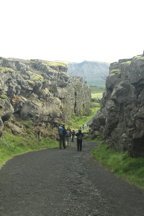
|
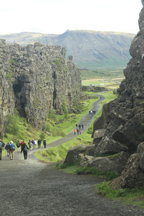
|

|
Historically, there’s much more: it was at Þingvellir that the first Icelandic Commonwealth was created in 970, and it was there that the annual legislative and judicial Assembly was held. As I understand it, each extended family, or clan, had a place they came back to every year. Each clan built a booth in that space big enough for people to sleep in; some of these were sunk into depressions carved out of the volcanic stone, which can be seen to this day. As usual, I neglected to photograph any of these. Nevertheless, I did get some nice shots of our group passing through the ravine called Almannagjá, one of the evidences in the landscape of the mid-ocean spreading. Upper left: big image, small; lower left: big image, small.
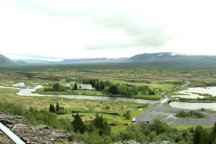
|
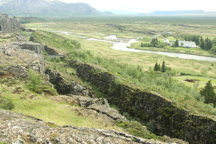
|
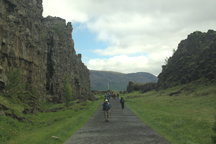
|
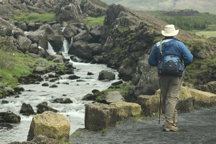
|
As you can see in the lower of those pictures, the path we took was rather higher than the floor of the valley. To the right, in the upper row, you see two broader views of the valley (left: big image, small; right: big image, small). In the lower row, a rather dark shot notable for showing Mark photographing the straggler of the group (big image, small). To the right of that, a shot of Mark walking along the Öxará (Axe River) (big image, small), which pours down the side of the volcanic cliff in Öxarárfoss (“foss” is the word for waterfall: we’ll see it again and again during the trip). There’s the falls to the left (big image, small).
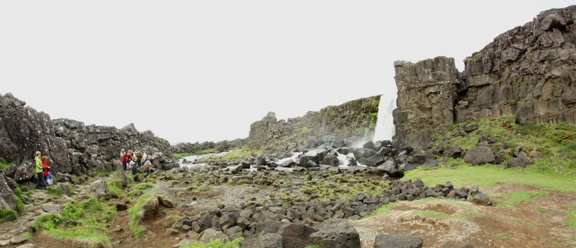
|
| A somewhat washed-out picture showing how Öxarárfoss sits in the landscape |
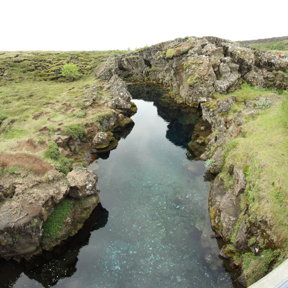
|
|
Coins have been thrown from the bridge into the water that fills the cleft here. |
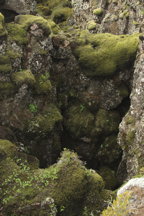
|
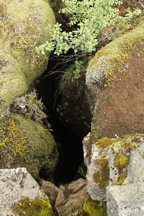
|
The clefts or ravines or chasms (all called “gjá” in Icelandic) weren’t all broad. We saw all sorts of pits or wells that pretty clearly arose from the spreading in the area. A real threat to toddlers, I thought when I saw them. Now, at home, it occurs to me that if they were in a National Park in the US, they would be filled with styrofoam cups. Left: big image, small; right: big image, small.
|
|
But I was hoping all along to get some nice wildflower pictures, and I think I did, though you should check Mark’s pages—I think a lot of his pictures are better than mine. You can see him trying to get a shot of something up close just to the left of here, below. (Big image, small.)
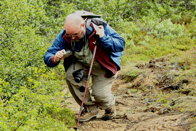
|
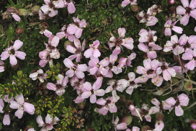
|

|
One aspect of the Icelandic flora that surprised me was the number of willows that can be found there, many of them dwarf or ground-hugging plants that I wouldn’t have known as willows without seeing their flowers. At the right, in the upper two pictures in the left-hand column here are two shots of Woolly Willow (Salix lanata), while the bottom picture in the column is Tea-leaved Willow (Salix phylicifolia). (In the left column, top: big image, small; middle: big, small; bottom: big, small.) In the right column is a horsetail (Equisetum pratense) that doesn't look a bit like the horsetails we have here in California, but rather much more like the ones growing by the side of the road where I grew up on Staten Island. (Big image, small.) Below that is the nice pink flower Lady Smock (Cardamine nymanni) (big, small).
Continuing with the wildflowers, over there on the left, below Mark taking his picture, is Wild Thyme (Thymus praecox), and then an amazing flower, Sea Campion (Silene uniflora). That bulbous thing is the flower’s calyx. (Thyme: big image, small; Sea Campion: big image, small.)
We continued on a nice long walk to the trail head, where Kristín and Hulda were waiting for us. Also waiting was a very pleasant luncheon, distinguished for me by the presence of monkfish, which I ordinarily don’t like, but which was prepared unusually well, roasted on skewers. Delicious.
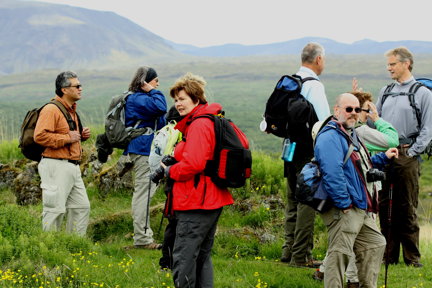
|
|
Group shot, one of the first I managed to grab. Left to right, Paul, Jerye, Gisele (behind her is Kay), John, Mark, Barbara, Erling. (Big version, small.) |
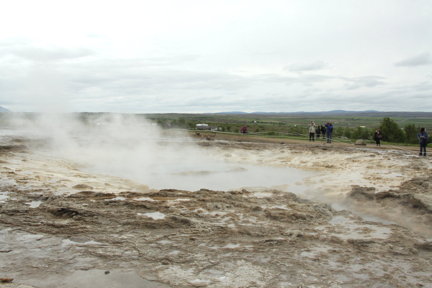
We got on the bus and drove to Geysir. That’s the original of all geysers, in the sense that they’re named for this one. The name means gusher, more or less. We didn’t see it do its thing: like many of us, it’s not what it used to be. But Mark got a nice action shot of the neighboring geyser called Strokkur, (Churn). Its eruptions are regular and frequent, roughly every five to ten minutes, but I think not as high as those of Old Faithful. For some reason, I got only one picture of Strokkur that was the least bit interesting, to the right here. (Big image, small—but still somewhat larger than the one here.) The area is full of little vents leaking sulfurous steam, and much of it is roped off from any tourists who might want to look one of those vents right in the eye—or other part of the anatomy, whichever one is most appropriate.
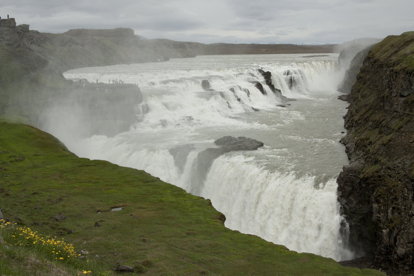
| ||||||||
| Big image, small. | ||||||||
|
Next, a real attraction: the great waterfall Gullfoss (Golden Falls), which is one of those things that everybody visiting Iceland sees. I even got to it in 1969, and have a few pictures of it from then. It’s really very impressive, loud, with plenty of spray to soak you. Don’t expect the water to be pure blue, though: it’s glacial, and very muddy.
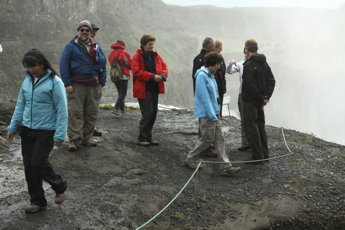
|
Over on the right, a picture showing many of the group at an observation point above the falls. Shirley, Mark, two people not in the tour, Gisele; and then in a row, Margie, John and Kristín; then Erling with Diane behind him. (Big image, small.)
From Gullfoss, we drove directly to Hótel Rangá in Hella, right on the banks of the Rang River, which is apparently one of the dozens (or is it hundreds?) of excellent salmon-fishing rivers in Iceland.
We were able to see Eyjafjallajökull when we arrived, very dimly through a lot of mist, but by the time dinner was over, it was completely invisible. I took some pictures early, and it can hardly be discerned at all, but I think Mark managed a little better.
We got settled, and then went for dinner. There was an interesting starter of cured lamb—“lamb pastrami”—and a main course of salmon from the river itself. Dessert was a pleasant simple plate of three kinds of ice cream.
Charlie Nielsen was something of a reprobate, a local character in our corner of Staten Island, who was one of a bunch of colorful oldsters that my step-father liked to bring home for supper. This was long after the days of Charlie’s “ranch”.
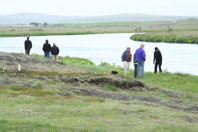
We had learned earlier in the day that a local stable was offering horseback riding afterwards for people who wanted to pay a supplement. Icelandic ponies! Very romantic, but ever since my terrifying ride on one of Charlie Nielsen’s ultratame, infinitely docile nags when I was about six, getting on top of a horse has never appealed to me. For the less adventurous, there would be a walk along the river bank. That’s what Mark and I did, and a bunch of the others as well. Most of the people in the picture to the left have their back to us, but in the right of the shot, you see Mark, Kevin, and Kristín (big image, small).

|
| Walking along the Rangá. Gisele, Ronnie, Kevin, Mark, Erling, Kristín, and Jerye |
And then we went to the bar to write up our journals, but I was fading so badly that I fled back to our room, to bed.
First part of next day’s pictures, previous day’s pictures. Return to the central Iceland page; to the central travel page; to my home page.